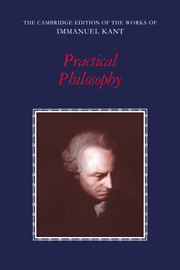Book contents
- Frontmatter
- Contents
- General editors' preface
- Preface
- General introduction
- Review of Schulz's Attempt at an introduction to a doctrine of morals for all human beings regardless of different religions (1783)
- An answer to the question: What is enlightenment? (1784)
- On the wrongfulness of unauthorized publication of books (1785)
- Groundwork of The metaphysics of morals (1785)
- Review of Gottlieb Hufeland's Essay on the principle of natural right (1786) [translated and edited by Allen Wood]
- Kraus's review of Ulrich's Eleutheriology (1788)
- Critique of practical reason (1788)
- On the common saying: That may be correct in theory, but it is of no use in practice (1793)
- Toward perpetual peace (1795)
- The metaphysics of morals (1797)
- On a supposed right to lie from philanthropy (1797)
- On turning out books (1798) [translated and edited by Allen Wood]
- Editorial notes
- Glossary
- Index of names
- Index of subjects
Critique of practical reason (1788)
Published online by Cambridge University Press: 05 June 2012
- Frontmatter
- Contents
- General editors' preface
- Preface
- General introduction
- Review of Schulz's Attempt at an introduction to a doctrine of morals for all human beings regardless of different religions (1783)
- An answer to the question: What is enlightenment? (1784)
- On the wrongfulness of unauthorized publication of books (1785)
- Groundwork of The metaphysics of morals (1785)
- Review of Gottlieb Hufeland's Essay on the principle of natural right (1786) [translated and edited by Allen Wood]
- Kraus's review of Ulrich's Eleutheriology (1788)
- Critique of practical reason (1788)
- On the common saying: That may be correct in theory, but it is of no use in practice (1793)
- Toward perpetual peace (1795)
- The metaphysics of morals (1797)
- On a supposed right to lie from philanthropy (1797)
- On turning out books (1798) [translated and edited by Allen Wood]
- Editorial notes
- Glossary
- Index of names
- Index of subjects
Summary
Introduction
In his Preface to the Groundwork of the Metaphysics of Morals Kant stated his intention of writing a book to be called The Metaphysics of Morals. There is no indication that he intended to produce a work entitled the Critique of Practical Reason. Metaphysics, he explained, has two parts, metaphysics of nature and metaphysics of morals, and just as a critique of pure speculative reason is the only foundation for a metaphysics of nature, so a critique of pure practical reason is the only foundation for a metaphysics of morals. However, what it was necessary and feasible to do could be done in the course of laying the foundation for the metaphysics of morals. Section III of the Groundwork, the transition to a “critique of pure practical reason,” would suffice.
By April 1786 Kant had begun his extensive revisions for the second edition of the Critique of Pure Reason and, early in the course of making them, apparently entertained the thought of adding to it a critique of practical reason. In November 1786 the Allgemeine Literaturzeitung, announcing the forthcoming publication of the new edition, said that in it a critique of pure practical reason would be appended to the critique of pure speculative reason contained in the first edition (AK 3:556). However, no such addition was made. In April 1787 Kant had completed his revisions, and his only extensive rewriting beyond the Transcendental Analytic was in the Dialectic's chapter on “The Paralogisms of Pure Reason,” a part having no direct bearing on moral philosophy.
- Type
- Chapter
- Information
- Practical Philosophy , pp. 133 - 272Publisher: Cambridge University PressPrint publication year: 1996
- 76
- Cited by



